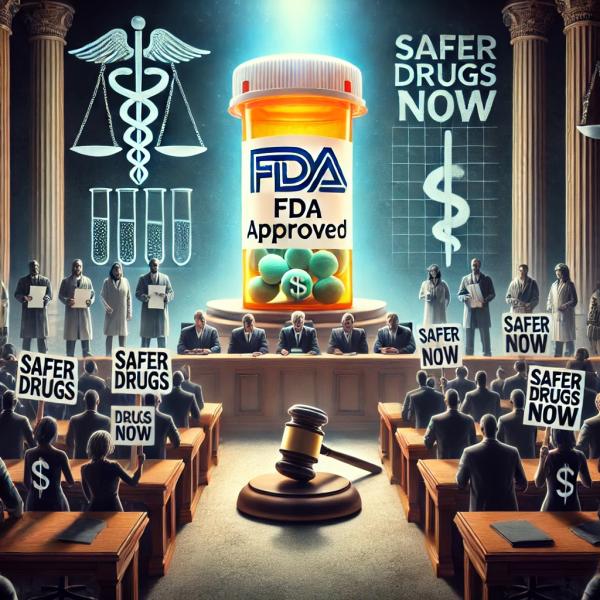
For decades, HIV sufferers were bereft of effective treatment. In 2001, five years after their tenofovir disoproxil fumarate (TDF) drugs were patented, Gilead Pharmaceuticals received FDA approval, and the drugs became prescribable. Finally, HIV sufferers had a real future. But no drug is perfect, and like other drugs, TDF has side-effects. These were known to the FDA - and disclosed to users – ample warnings were placed on package labeling and included in safety inserts. Millions took the drug and reaped its benefits.
A Sordid History
Now, some twenty years after TDF became available the plaintiffs’ bar seeks to upend pharmaceutical production. Their suit threatens not just this drug -- but all drugs, as the plaintiffs’ bar seek to coopt the drug-development decisions -making process. substituting their divine judgment for that of pharmaceutical experts. So far, their claims have received judicial sanction. They are now on appeal before the California Supreme Court.
Since 2018, some 24,000 cases have been filed against Gilead, not for manufacturing defective drugs (marketed as Viread and Truvada), not for drugs claimed to be unreasonably dangerous, not for failing to warn about known dangers. The plaintiffs don’t even take issue with the FDA’s approval.
Nor do the plaintiffs allege that the medications failed to work as intended; indeed, patients are alive today because of TDF. The plaintiffs can’t say Gilead did anything wrong in manufacturing and marketing it. But that isn’t good enough.
Instead, they claim a negative: that Gilead is liable for not pursuing production of a different drug, tenofovir alafenamide or TAF, which they claim was safer and which was in the early stages of the drug-development pipeline when TDF was marketed and its dosage regimen refined.
The plaintiffs’ information center website even admits that Truvada and Viread are really good drugs, conceding (charitably) that:
“When they first came on the market in the early 2000s, Viread and Truvada were touted as significant advancements in the fight against AIDS. …Truvada and Viread were viewed as groundbreaking drugs when they first came out, and they were the only real treatment option for people living with HIV. Within a few years, millions of patients were taking Viread or Truvada daily for HIV treatment.”
Gilead’s website explains their defense, presenting multiple supporting briefs by academic, professional, and industrial groups, primarily arguing the lack of precedent for the plaintiffs product liability claim, which even the plaintiffs’ bar admits is novel, never recognized anywhere in the country – save for the California case now on appeal. They are correct. To sustain such a claim the plaintiffs must prove that the risks outweigh the drug’s benefits. They don’t.
However, the plaintiffs are focusing on a different theory, that of negligence, citing California Civil Code Section 1714’s general duty of “ordinary care” and claiming that Gilead should have brought the allegedly safer TAF, rather than the FDA-approved as safe TDF, to market.
The Acid Test of Ordinary Care
As I’ve explained previously, sustaining a negligence claim requires establishing a “duty of ordinary care.” This duty derives from what reasonable people would expect and do under the circumstances. Even in California, this claim based on common law, has definable parameters. As articulated in 1947 by Judge Learned Hand in United States v. Carroll Towing Co., the degree of care required of an actor is calibrated by balancing the burden on the actor to remedy a harm (B), against the probability (P) that harm would occur, considering its gravity (G). This concept is commonly depicted as B=P x G. In assessing liability, the parameters of these variables must be known with a fair degree of certainty. Under this rubric, the plaintiffs’ claim must fail, since those variables couldn’t be calculated when the alleged claim arose.
Plaintiffs sets up the facts to maintain this imaginary claim by arguing that:
- In 2004, Gilead decided to delay developing TAF.
- The previously FDA-approved TDF-medications (which likely kept them alive) caused kidney and bone injuries.
- These harms would have been avoided had Gilead developed TAF earlier.
Plaintiffs thus saddle Gilead with weighing production and refinement of the FDA-approved TDF drugs versus the burden of developing a different drug which includes the delay in securing FDA approval, along with weighing the comparative probabilities and gravities of harm - even before such knowledge is available. Their claim creates a novel comparative duty of ordinary care (never previously invoked in this context), and one not recognized in law.
There are several problems with this argument. When Gilead decided to focus its activities on refining TDF’s dosage regimen instead of devoting corporate assets to taking TAF to market, the legally required “knowledge” of TAF-safety (i.e., the probability as well as the gravity of harm) was non-existent. The allegedly “negligent” decision was made very early in the development process when “the only clinical trial … conducted was a 14-day, Phase I/II study … of 30 subjects, only 20 of whom received TAF.” Without a Phase III trial, FDA approval is not obtainable, and reliable knowledge of probability and gravity of harm is unknown. The requisite burden of care simply cannot be calculated - because Gilead didn’t have the knowledge to do so. That would take years and significant costs.
Safe, Safer, Safest
Even assuming that using TAF could have prevented the harms claimed (and the plaintiffs would not have died from AIDs before TAF was approved), the ordinary care standard presupposes a reasonable consumer test, i.e, what an ordinary user, our would-be plaintiff, would have expected. It is hardly likely than any pharmaceutical user would expect a degree of safety “safer” than FDA approval.
While the plaintiffs’ tout TAF as “safer” than the FDA-approved TDF, this isn’t necessarily so. That claim, even if it has some truth, is skewed; it applies only the plaintiffs (and their lawyers) bringing this action. In reality, there is a separate cohort for whom TDF is the “safer” drug, and their interests were better served by Gilead’s efforts to maximize TDF’s effectiveness.
According to POZ an online patient advocacy group and magazine:
“TDF leads to lower cholesterol and triglyceride levels, which can lessen cardiovascular risk. TAF does not have the same beneficial effect on blood lipids, and it may be linked to greater weight gain.”
Public Policy, Progress, and Unintended Consequences
Nor, as a matter of policy, should the law countenance such an expectation. What the plaintiffs are demanding is a degree of safety equaling the “safest” possible. That standard is simply too costly for any economy to endure, even if it could be achieved. Firstly, it is always possible to achieve a higher level of safety than presently exists; theoretically, no product would ever be brought to market as you could always, with enough time and money, make it safer. Secondly, the costs needed to underwrite this standard would be prohibitive. Thirdly, this standard would block mergers and acquisitions between drug companies, as any product in either company’s pipeline could saddle a corporate collaborator with liability. In short, progress would die.
The pending suit would also eviscerate the purpose of the FDA. Their job is to assess drugs (and medical devices), weighing risks and benefits and setting a safety floor. That standard does not require absolute safety, for there is always sure to be “safer.” (And actually, nothing is absolutely safe, not even oxygen, water, or sunlight). Nor, do applicable standards require older drugs to be removed if newer, safer alternatives become available. In fact, TDF is still marketed. It has never been recalled, and is among the regimens for HIV antiretroviral therapy recommended by the US Department of Health and Human Services; the World Health Organization continues to refer to TDF as “essential to HIV treatment.”
The plaintiffs’ website is hopeful of securing a mass settlement. I call their antics baseless bullying.
Disclaimer: It should be noted that a member of ACSH’s Board has worked for Gilead. The Board and all its members, and our administration were not involved in developing this article or its contents. It is the sole work of the author, who has no ties to Gilead or any other drug manufacturer.



